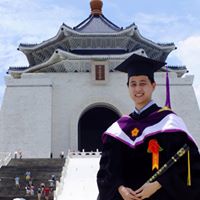Xiao Jing Chen
age ~36
from Bensalem, PA
- Also known as:
-
- Xiao J Chen
- Phone and address:
- 3390 Knights Rd, Bensalem, PA 19020
Xiao Chen Phones & Addresses
- 3390 Knights Rd, Bensalem, PA 19020
- Cornwells Heights, PA
- Philadelphia, PA
- Pittsburgh, PA
- Grand Island, NY
Isbn (Books And Publications)

Yu Liao Ku Zai Wai Yu Jiao Yu Zhong De Ying Yong: Li Lun Yu Shi Jian = Application of Corpora to Foreign Language Education Theory and Practice
view sourceAuthor
Xiao Chen
ISBN #
7536130589
License Records
Xiao Chen
License #:
32278 - Active
Issued Date:
Aug 5, 2014
Renew Date:
Dec 1, 2015
Expiration Date:
Nov 30, 2017
Type:
Certified Public Accountant
Us Patents
-
Spiro-Cyclic -Amino Acid Derivatives As Inhibitors Of Matrix Metalloproteases And Tnf- Converting Enzyme (Tace)
view source -
US Patent:6720329, Apr 13, 2004
-
Filed:Mar 12, 2002
-
Appl. No.:10/096804
-
Inventors:Gregory R. Ott - Media PA
Xiao Tao Chen - Newark DE
Jingwu Duan - Newark DE
Matthew E. Voss - Lincoln University PA -
Assignee:Bristol-Myers Squibb Pharma - Princeton NJ
-
International Classification:A61K 31443
-
US Classification:514278, 514342, 514339, 514336, 546 15, 546152, 5462681, 5462764, 5462797, 5462817
-
Abstract:The present application describes novel spiro-cyclic -amino acid derivatives of formula I: or pharmaceutically acceptable salt forms thereof, wherein ring B is a 3-13 membered carbocycle or heterocycle, ring C forms a 3-11 membered spiro-carbocycle or spiro-heterocycleon ring B, and the other variables are defined in the present specification, which are useful as as matrix metalloproteinases (MMP), TNF- converting enzyme (TACE), and/or aggrecanase inhibitors.
-
Spiro-Cyclic Β-Amino Acid Derivatives As Inhibitors Of Matrix Metalloproteases And Tnf-Α Converting Enzyme (Tace)
view source -
US Patent:6962938, Nov 8, 2005
-
Filed:Dec 18, 2003
-
Appl. No.:10/741326
-
Inventors:Gregory R. Ott - Media PA, US
Xiao Tao Chen - Furlong PA, US
Jingwu Duan - Yardley PA, US
Matthew E. Voss - Lincoln University PA, US -
Assignee:Bristol-Myers Squibb Pharma Company - Princeton NJ
-
International Classification:A61K031/403
A61K031/38
C07D327/04
C07D207/04
C07D207/18 -
US Classification:514409, 514438, 514462, 549 30, 549200, 549300, 549322, 549337, 549341, 548407
-
Abstract:The present application describes novel spiro-cyclic β-amino acid derivatives of formula I: or pharmaceutically acceptable salt forms thereof, wherein ring B is a 3-13 membered carbocycle or heterocycle, ring C forms a 3-11 membered spiro-carbocycle or spiro-heterocycleon ring B, and the other variables are defined in the present specification, which are useful as as matrix metalloproteinases (MMP), TNF-α converting enzyme (TACE), and/or aggrecanase inhibitors.
-
Beta-Arrestin Effectors And Compositions And Methods Of Use Thereof
view source -
US Patent:20130196902, Aug 1, 2013
-
Filed:Jan 31, 2013
-
Appl. No.:13/755637
-
Inventors:Dennis Yamashita - Wayne PA, US
Xiao Tao Chen - Furlong PA, US -
Assignee:Trevena, Inc. - King of Prussia PA
-
International Classification:C07K 7/06
-
US Classification:514 37, 530328, 514 217, 514 164
-
Abstract:This application describes compounds acting as, for example, β-arrestin effectors and uses thereof, in, for example, the treatment of chronic and acute cardiovascular diseases.
-
Quinoxalines And Aza-Quinoxalines As Crth2 Receptor Modulators
view source -
US Patent:20130303517, Nov 14, 2013
-
Filed:Dec 19, 2011
-
Appl. No.:13/996361
-
Inventors:Christopher W. Boyce - Flemington NJ, US
Sylvia Joanna Degrado - Scotch Plains NJ, US
Xiao Chen - Edison NJ, US
Jun Qin - Edison NJ, US
Younong Yu - East Brunswick NJ, US
Kevin D. McCormick - Basking Ridge NJ, US
Anandan Palani - Bridgewater NJ, US
Dong Xiao - Warren NJ, US
Robert George Aslanian - Rockaway NJ, US
Jie Wu - Scotch Plains NJ, US
Ashwin Umesh Rao - Morganville NJ, US
Phieng Siliphaivanh - Newton MA, US
Joey L. Methot - Westwood MA, US
Hongjun Zhang - Newton MA, US
Elizabeth Helen Kelley - Lynnfield MA, US
William Colby Brown - Cleveland Heights OH, US
Qin Jiang - Latham NY, US
Jolicia Polivina Gauuan - Schenectady NY, US
Andrew J. Leyhane - Latham NY, US
Purakkattle Johny Biju - Piscataway NJ, US
Pawan K. Dhondi - Elizabeth NJ, US
Li Dong - Lawrenceville NJ, US
Salem Fevrier - Cranford NJ, US
Xianhai Huang - Warren NJ, US
Henry M. Vaccaro - South Plainfield NJ, US -
International Classification:C07D 241/42
C07D 401/12
C07D 403/06
C07D 471/04
A61K 31/4985
C07D 471/10
C07D 405/12
C07D 401/14
A61K 31/506
A61K 31/55
C07D 417/12
C07D 498/04
C07D 491/107
A61K 45/06
A61K 31/498 -
US Classification:51421018, 544353, 514249, 544350, 544230, 51421021, 544295, 540523, 51421207
-
Abstract:The invention provides certain quinoxalines and aza-quinoxalines of the Formula (I), and their pharmaceutically acceptable salts, wherein J, J, R, R, R, R, R, R, R, R, X, Y, b, n, and q are as defined herein. The invention also provides pharmaceutical compositions comprising such compounds, and methods of using the compounds for treating diseases or conditions associated with uncontrolled or inappropriate stimulation of CRTHfunction.
-
K-Space Trajectory Infidelity Correction In Magnetic Resonance Imaging
view source -
US Patent:20210272335, Sep 2, 2021
-
Filed:Mar 2, 2020
-
Appl. No.:16/805903
-
Inventors:- Erlangen, DE
Xiao Chen - Princeton NJ, US
Mariappan S. Nadar - Plainsboro NJ, US
Boris Mailhe - Plainsboro NJ, US
Simon Arberet - Princeton NJ, US -
International Classification:G06T 11/00
G06T 7/00
G06T 15/08 -
Abstract:For k-space trajectory infidelity correction, a model is machine trained to correct k-space measurements in k-space. K-space trajectory infidelity correction uses deep learning. Trajectory infidelity is corrected from a k-space point of view. Since the image artifacts arise from k-space acquisition distortion, a machine learning model is trained to correct in k-space, either changing values of k-space measurements or estimating the trajectory shifts in k-space.
-
Unsupervised Learning-Based Magnetic Resonance Reconstruction
view source -
US Patent:20210150783, May 20, 2021
-
Filed:Nov 19, 2019
-
Appl. No.:16/688170
-
Inventors:- Erlangen, DE
Boris Mailhe - Plainsboro NJ, US
Xiao Chen - Princeton NJ, US
Mariappan S. Nadar - Plainsboro NJ, US -
International Classification:G06T 11/00
G06N 3/08
G06N 3/04
G16H 30/40
G06T 7/00 -
Abstract:For magnetic resonance imaging reconstruction, using a cost function independent of the ground truth and many samples of k-space measurements, machine learning is used to train a model with unsupervised learning. Due to use of the cost function with the many samples in training, ground truth is not needed. The training results in weights or values for learnable variables, which weights or values are fixed for later application. The machine-learned model is applied to k-space measurements from different patients to output magnetic resonance reconstructions for the different patients. The weights and/or values used are the same for different patients.
-
Medical Image Segmentation From Raw Data Using A Deep Attention Neural Network
view source -
US Patent:20200065969, Feb 27, 2020
-
Filed:Jul 9, 2019
-
Appl. No.:16/506123
-
Inventors:- Erlangen, DE
Xiao Chen - Princeton NJ, US
Mariappan S. Nadar - Plainsboro NJ, US
Boris Mailhe - Plainsboro NJ, US -
International Classification:G06T 7/11
G06T 7/00
G06N 3/08
G16H 50/50
G06N 3/04
G06N 20/00 -
Abstract:Various approaches provide improved segmentation from raw data. Training samples are generated by medical imaging simulation from digital phantoms. These training samples provide raw measurements, which are used to learn to segment. The segmentation task is the focus, so image reconstruction loss is not used. Instead, an attention network is used to focus the training and trained network on segmentation. Recurrent segmentation from the raw measurements is used to refine the segmented output. These approaches may be used alone or in combination, providing for segmentation from raw measurements with less influence of noise or artifacts resulting from a focus on reconstruction.
-
Motion Determination For Volumetric Magnetic Resonance Imaging Using A Deep Machine-Learning Model
view source -
US Patent:20200049785, Feb 13, 2020
-
Filed:Oct 17, 2018
-
Appl. No.:16/162559
-
Inventors:- Erlangen, DE
Xiao Chen - Princeton NJ, US
Silvia Bettina Arroyo Camejo - Nuremberg, DE
Benjamin L. Odry - West New York NJ, US
Mariappan S. Nadar - Plainsboro NJ, US -
International Classification:G01R 33/565
G06T 11/00
G06N 3/08
G06F 15/18
G01R 33/48 -
Abstract:For determination of motion artifact in MR imaging, motion of the patient in three dimensions is used with a measurement k-space line order based on one or more actual imaging sequences to generate training data. The MR scan of the ground truth three-dimensional (3D) representation subjected to 3D motion is simulated using the realistic line order. The difference between the resulting reconstructed 3D representation and the ground truth 3D representation is used in machine-based deep learning to train a network to predict motion artifact or level given an input 3D representation from a scan of a patient. The architecture of the network may be defined to deal with anisotropic data from the MR scan.
Lawyers & Attorneys

Xiao di Chen - Lawyer
view sourceLicenses:
New York - Currently registered 2012
Education:
St. John's University Law School
Name / Title
Company / Classification
Phones & Addresses
CHEN LIU LLC
AURIMAX INTERNATIONAL LTD
Myspace
Googleplus

Xiao Chen
Work:
ND (2008)
Tagline:
加入Google+咯~~~

Xiao Chen
Education:
East China University of Politics and Law - Civic and commercial law

Xiao Chen
Tagline:
Male, Married, born in Hangzhou, China

Xiao Chen

Xiao Chen

Xiao Chen

Xiao Chen

Xiao Chen
Flickr
Plaxo

Xiao Chen
view source
xiao chen
view source
Xiao CHEN
view sourceCarrefour Global Sourcing

chen xiao ming
view sourcetechnical at boom bamm

chen xiao long
view sourceBeijingsfortware engineer at IBM
Classmates

Xiao Chen
view sourceSchools:
Vancouver Technical Secondary School Vancouver Saudi Arabia 1997-2001
Community:
Lynda Doucette, Carol Stewart, Kate Howarth

Xiao En Chen
view sourceSchools:
Michigan State Universirty East Lansing MI 2002-2006
Community:
William Leppert, Mary Mcintyre

Xiao Chen
view sourceSchools:
West Valley High School Fairbanks AK 2003-2007
Community:
Julie Howell, Kelly Gentle

Xiao Chen
view sourceSchools:
Boston Latin Academy Boston MA 1990-1994
Community:
Phillip Aylward, Tina Mcgrath, Cathe Jones, Penny Bennett, Karen Sumpter

Xiao Wei Chen
view sourceSchools:
Valley Oak Elementary School Davis CA 1996-2000
Community:
Jeff Schwab

Xiao Hua Chen
view sourceSchools:
Billings Middle School Seattle WA 2001-2002
Community:
Zoe Bloom, Abby Pitts, Abigail Pitts

Xiao Chen (Chenxiao)
view sourceSchools:
Changping High School Shanghai China 1996-2000
Community:
Fanlong Zeng, Jiang Qian, Tom Pan, Wang Wang, Wang Juan, Yongshan Bao

Xiao Chen
view sourceSchools:
Linden City Elementary School 6 Linden NJ 1994-1998
Community:
Steven Rodriguez, Maria Pierre, Sandra Alvarez, Takiyah Britton, Kamil Nitka, Tomasz Regula, Evelyn Szabela, Justin Arias, Vanessa Vasquez, Maesoon Deeb, Edwin Velez
Youtube

Xiao Sheng Chen
view source
Xiao Guang Chen
view source
Xiao Elaine Chen
view source
Xiao Qing Chen
view source
Xiao Yang Chen
view source
Xiao Chen
view source
Xiao Chen
view source
Xiao Qian Chen
view sourceNews

Hong Kong protests, as seen by Chinese mainlanders
view source- Hong Kong people should have a world view, and not only focus on one citys arguments. Its not easy for the U.S. to create a disturbance in China, but its super easy to rock the boat through Hong Kong, Xiao Chen wrote.
- Date: Oct 02, 2014
- Category: Sci/Tech
- Source: Google
Get Report for Xiao Jing Chen from Bensalem, PA, age ~36















